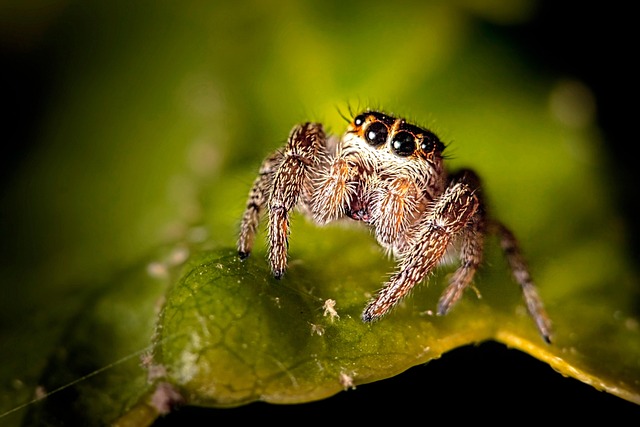Understanding spider behavior is key to developing humane, eco-conscious methods of prevention. Different species have unique habits influenced by food, temperature, and humidity. Common household spiders prefer warm, dark, undisturbed areas, making regular cleaning and decluttering crucial to eliminate attractive habitats. Eco-friendly solutions include natural deterrents like essential oils (citrus, peppermint, lavender, tea tree), sealing gaps with natural materials, and introducing beneficial insects for population control. Sticky traps and vacuum cleaners offer chemical-free extermination methods. Community education on these eco-friendly practices enhances spider prevention while fostering a sustainable, harmonious coexistence with arachnids.
Spiders can be both fascinating and frightening creatures, but with humane and eco-conscious approaches, it’s possible to manage their presence in our homes and communities. This article explores effective yet gentle strategies for dealing with spiders, focusing on understanding their behavior and habitat preferences. We’ll delve into eco-friendly solutions for prevention, the power of natural repellents, safe extermination methods, and community initiatives aimed at reducing spider populations naturally. Discover these innovative and sustainable practices for eco-friendly spider prevention solutions.
Understanding Spider Behavior and Their Habitat Preferences
Understanding spider behavior is key to developing humane and eco-conscious approaches for their prevention. Spiders are arachnids with a diverse range of species, each with unique habits. They are often attracted to specific environments based on food availability, temperature, and humidity. Common household spiders, like the house spider (Parasteatoda tepidariorum), prefer warm, dark, and undisturbed areas such as corners, attics, or crawl spaces. Knowing these preferences allows us to implement eco-friendly strategies.
By identifying and sealing entry points, maintaining excellent sanitation, and using natural deterrents like citrus peels or lavender, we can create an environment less appealing to spiders. Eco-friendly spider prevention solutions focus on non-toxic methods that disrupt their habitat without causing harm. These strategies not only keep spiders at bay but also promote a healthier balance within our ecosystems.
Eco-Friendly Strategies for Spider Prevention in Your Home
When it comes to keeping spiders out, many conventional methods involve harsh chemicals and toxic traps, which can be detrimental to both your health and the environment. Fortunately, there are numerous eco-friendly strategies that offer effective spider prevention solutions for your home without compromising your well-being or contributing to ecological damage. One of the most straightforward approaches is maintaining a clean and clutter-free living space. Spiders are attracted to dark, secluded areas where they can build webs and go unnoticed, so regular cleaning and decluttering can significantly deter them.
Additionally, using essential oils known for their natural pest-repelling properties can be an excellent alternative. Oils like citrus, peppermint, lavender, and tea tree oil have been shown to repel spiders due to their strong odours. You can diffuse these oils in your home or create homemade spider repellents by mixing them with water and spraying the solution around entry points and potential hiding places. Other eco-friendly tactics include sealing gaps and cracks in walls and windows using natural materials like silk or cotton, and introducing natural predators like ladybugs and spiders that feed on other pests to maintain a balanced ecosystem within your home.
Natural Repellents and Safe Extermination Methods
Spiders can be a nuisance, but opting for humane and eco-conscious approaches to their prevention is essential. Natural repellents offer a safe alternative to toxic chemicals. Essential oils like citronella, peppermint, and tea tree oil are known to deter spiders due to their strong aromas. These natural scents can be used in diffusers, sprays, or even mixed with water and sprayed around problem areas. Another eco-friendly method is using beneficial insects, such as spider mites that feed on other pests, including spiders.
When it comes to extermination, there are safe and effective methods that minimize harm to the environment and non-target species. Sticky traps are a popular choice for capturing spiders without causing them distress. These traps use a sticky surface to ensnare spiders, allowing for their removal from homes or gardens without chemicals. Additionally, using a vacuum cleaner can be an efficient way to eliminate spiders and their webs. This simple method ensures the safe removal of these arachnids while maintaining a clean living space.
Community and Outdoor Approach to Reducing Spider Populations
In many cases, a community and outdoor approach can significantly reduce spider populations while minimizing harm to both humans and the environment. Eco-friendly spider prevention solutions start with understanding the natural habitats and behaviors of spiders. By maintaining clean and clutter-free outdoor spaces, especially in areas around homes and businesses, you can limit their food sources and hiding places. Regularly trimming bushes, mowing lawns, and removing piles of wood or debris provides less opportunities for spiders to thrive.
Community efforts, such as organized cleaning campaigns and public education programs, can further reinforce these practices. Sharing knowledge about spider habits and the use of natural repellents, like peppermint oil or lavender, can empower residents to take proactive steps. These collaborative actions not only reduce spider presence but also foster a more harmonious relationship between humans and arachnids, ensuring both safety and environmental sustainability.
In conclusion, humane and eco-conscious approaches to spider prevention involve understanding their behavior, utilizing natural repellents, adopting safe extermination methods, and fostering a community and outdoor strategy. By implementing these eco-friendly spider prevention solutions, we can create a healthier environment for both humans and spiders while maintaining a comfortable living space. Remember that subtle adjustments in our homes and outdoor spaces can make a significant difference in reducing spider populations without causing harm to these fascinating arachnids.
